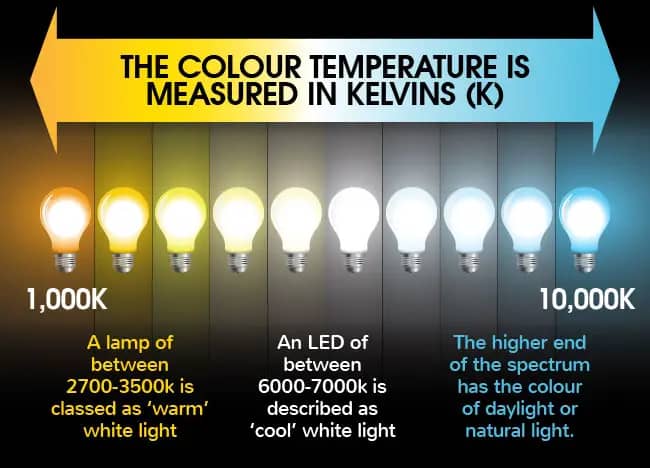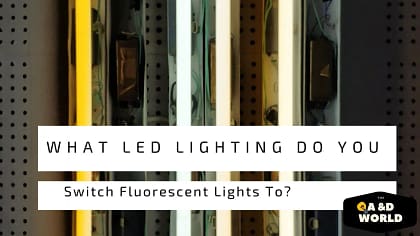Soft White Vs Bright White Vs Daylight Bulbs. Which is the best color temperature for your home?
Light bulbs are one of the best inventions known to man. They are an important factor when illuminating modern homes. In the early days, light bulbs were measured in wattage.
While you can still see these numbers on most bulbs’ packaging, lumens and Kelvin is the true indicator of brightness and color temperature.
When choosing a color temperature for your home, the room, the purpose, and the design play an important role. For instance, in such a vital room as the kitchen, you will need a cozy and inviting color temperature.
What Is Color Temperature?
| Color temperature | 2700K | 3000K | 5000K |
| Light Appearance | Warm White | Warm white | Cool daylight |
| Ambiance | Cozy | Warm and inviting | Crisp |
| Best For | Living rooms, kitchens, and bedrooms. | Bathroom and entryways | Basements and garages |
| Locations | Table and floor lamps, pendants, chandeliers | Vanities, overhead lighting | Task and security lighting. |
A soft white has a yellowish hue and emits 2700-3000K and is used in most homes.
They offer a warm and inviting feel to your home, and you can use them in your living room and bedroom. Compared to the bright white bulb which emits a whiter hue than soft white. This ranges from 3500-4500K and is the best in the bathroom, outdoors, and the workplace.
Daylight color temp gives out a 5000-6500K with a blueish–whitish hue and looks like a cloudless day. They are best for the workplace, accent lighting, and reading.
What Is Kelvin And Color Temperature?

Kelvin measures the color temperature of a light source by describing the warmth or coolness of the bulb. So the higher the Kelvin, the whiter the hue of the light-emitting from that bulb will be.
Similarly, most households have bulbs with a color temperature of 2700K (warm incandescent), 3000K (warm white halogen), and 3500K (household fluorescent).
Higher color temperatures like 3500K are used in public spaces, such as police stations or hospital settings. They can be too bright for interior design. However, you can get away with this color temperature when task lighting.
Understanding LED Lights
Incandescent or conventional bulbs will not give out a white shade as power is transferred through a wire through a tungsten filament in the lamp. It glows when it gets hot and gives light. Modern lamps with LED bulbs give out a soft white hue, like warm and cool white bulbs.
You can create the white light in two ways; mixing the color lights to create a white hue or using a phosphor coat on blue LED lights. When this happens, it emits a yellow light, giving off a white effect.
Each color temperature has different Kelvin measurements and emits a different color light. All have their specific purpose, and it is best to mix and match to get the setting you are looking for.
Which is better Soft White Vs Daylight?
Remember, soft white gives out a warm tone while daylight bulbs have a more cool white and bluish tones. Therefore, soft white is perfect for residential homes, and daylight is best for commercial buildings. You can also use daylight bulbs for garages, offices, and display cases.
Choosing between them both solely depends on where you are installing them. Having a too-bright kitchen or bedroom can affect your eyes or make it difficult to sleep. However, daylight bulbs have the highest color temperature and look more natural, especially in selfies and makeup applications.
Testing Soft White And Daylights Bulbs
When testing, I saw the difference in color with each bulb. That was expected. I use the socket in my kitchen and one in my bedroom. They both have the same cream color walls. With the soft white bulbs, I found the wall looked yellowish.
With the daylight bulb in the same room, the walls appeared white. Thus, it is safe to say that each bulb changes the hue of the paint on the walls.
Websites like Martha Stewart explored the effects of color temperatures on paints. They found that artificial lighting can control the hues on your walls.
They believe daylight bulbs can make the paint on your walls look consistent no matter the time- day or night. While soft white can make bright colors appear natural, dark colors look dull.

Daylight Vs Soft White For The Living Room- Which Is Better?
With interior lighting, it’s essential to make the right choice for your room. I’ll go over some attributes of each bulb and explain which one is best for your living room.
Daylight bulbs are an excellent choice for task lighting. Their brightness is especially suited to areas where you need to focus on detailed work (such as sewing or cooking).
The light from these bulbs is often described as “clinical,” so it may not be the best option for areas where you want a more relaxed ambiance. Thus, you will find them in the kitchen or home offices, and they are not the most suitable color temperature for the living room.
Similarly, as their name implies, soft white bulbs emit a softer light than daylight bulbs. It has been described as “warm” or “inviting,” making it a good choice for rooms where you want people to feel relaxed and at ease.
Therefore, if your living room is used for more casual activities like relaxing with family or entertaining guests, you may prefer a more soothing light that a soft white bulb provides.
Finding A Light Bulb
Choosing the right light bulb is a matter of preference. But there are some good guidelines to keep in mind when you’re shopping for new bulbs.
The most important thing to look for is brightness, measured in lumens. The higher the number, the brighter the light will be.
You can also choose between incandescent, CFLs, and LED bulbs. Incandescent bulbs generate a lot of heat, while LED bulbs and CFLs are more efficient and last longer than incandescent (about 10 times longer).
If you want high-quality lighting, that’s easy on your budget, consider LEDs. The style of the bulbs also is essential. Are you using it for recessed lighting or a fixture? Then, there are dimmable and non-dimmable bulbs.
Smart lighting is all the rave these days, and for good reasons. They come with many features, including third-party integration, voice commands, and Bluetooth, just to name a few.
Soft White Vs Warm White Bulbs
While they both emit a similar warm light, they can create different tones in a room. Here is an easy way to understand the difference between them:
Soft white (2,700 to 3,000 Kelvin) is warm and yellow, the typical color range of incandescent bulbs. This light gives a warm and cozy feeling and is often best for living rooms.
Warm white (3,000 to 4,000 Kelvin) is more yellowish-white. These bulbs are best suited for kitchens and bathrooms.
Cool White Vs Warm White
Cool white and warm white are two shades of white light popular in home lighting. While each of these shades can be attractive, they have different purposes within the home. Here is a closer look at cool white and warm white bulbs and their uses.
What Is Cool White Light?
Cool white light (4000K) is a shade of white with blue undertones. Bulbs with this color give off bright, crisp lighting that replicates natural daylight.
These lights are a good choice for task lighting or overhead lighting for an entire room. Many people prefer cooler tones for bathrooms, kitchens, garages, and basements.
What Is Warm White Light?
Warm white light (3000K) is like natural candlelight or sunlight that shines through clouds. This shade has yellowish undertones instead of blue undertones, as cool white light does.
These warmer shades work well in rooms where people like to relax, such as bedrooms and living rooms. People may also choose them for dining rooms because warm tones make food look more appetizing.
The Best Color Temperature For Your Kitchen
The best color temperature for the kitchen, according to the experts, is between 2700K and 3000K.
You can get this effect by using LED bulbs. These are efficient and generate less heat. They also come in a variety of styles and are perfect for any color contrast.
When choosing to light for your kitchen, there are several options available:
Recessed Lighting
Recessed lights are enclosed in opaque housing that’s installed into the ceiling. They provide an even, diffused light that’s ideal for general illumination in kitchens.
Under-Cabinet Lights
These lights are installed under cabinets to illuminate the countertop area below them. They’re portable and easy to install or remove.
Spotlights
Spotlights focus light on specific areas, like islands or other open spaces. Further, you can install them above cabinets or along walls.
Pendants
Pendant lights are installed on the ceiling and hang over your worktop or island. They’re great for adding task lighting and come in many styles.





